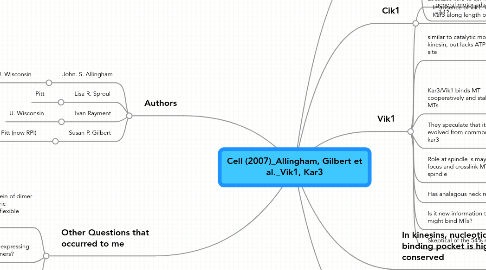
1. Kar3
1.1. N-terminal region for cargo-binding
1.2. Role in karyogamy and vegetative growth
1.2.1. nuclear fusion event during mating
1.3. One of 6 kinesins in s. cerev.
1.3.1. only kinesin-14
1.3.1.1. motor domain is at c-term
1.3.1.2. minus-directed
1.4. Forms heterodimer in vivo
1.4.1. either cik1
1.4.2. or vik1 (vik1 not a motor)
1.5. Question: Should we not think of Kar3 as the "special" part of the heterodimer, but rather as a general motor adapter for proteins like cik1 or vik1?
2. Cik1
2.1. In absence of vik1, localizes Kar3 along length of spindle
3. Vik1
3.1. Localizes kar3 to spindle poles
3.2. similar to catalytic motor core of kinesin, but lacks ATP-binding site
3.2.1. At c-terminus, like kinesin-14s
3.2.1.1. For some reason, I noted this as important because of symmetry of coiled-coil (I guess I meant that it has to match it's partner in terms of which end it's at)
3.3. Kar3/Vik1 binds MT cooperatively and stabilizes MTs
3.4. They speculate that it may have evolved from common ancestor with kar3
3.5. Role at spindle is maybe to focus and crosslink MTs @ spindle
3.6. Has analagous neck region to NCD
3.7. Is it new information that it might bind MTs?
3.8. Skeptical of the 54% result
4. Authors
4.1. John. S. Allingham
4.1.1. U. Wisconsin
4.2. Lisa R. Sproul
4.2.1. Pitt
4.3. Ivan Rayment
4.3.1. U. Wisconsin
4.4. Susan P. Gilbert
4.4.1. Pitt (now RPI)
5. In kinesins, nucleotide binding pocket is highly conserved
6. NCD may only bind with one head
7. Other Questions that occurred to me
7.1. What would happen if make fusion protein of dimer of kinesin 14 and kinesin-1? (not chimeric monomers, but each motor linked by a flexible linker perhaps)
7.2. What about expressing kinesin-1 dimers?
7.2.1. I believe it was the Diehl lab at the 2010 Biophys Meeting that showed this (think they've been doing it a while)...the kinesin "scaffolds"
7.2.1.1. 1924-POS BOARD #B722 MULTIPLE INTERACTING KINESIN-1 MOTORS COOPERATE NEGATIVELY. Michael R. Diehl, D. Kenneth Jameson, Mathew Zimmerman, Jonathan D. Driver, Arthur R. Rogers.
7.3. Apryase
7.3.1. http://en.wikipedia.org/wiki/Apyrase
